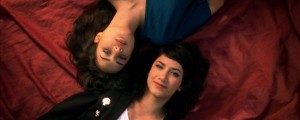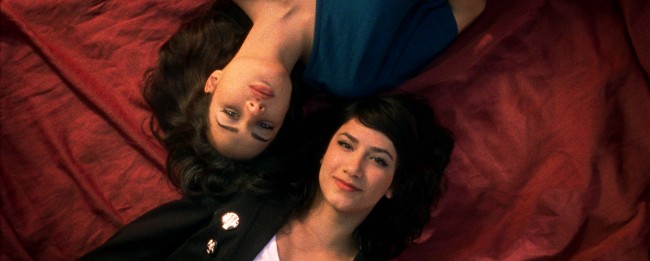Hollywood Soapbox talks with ‘Circumstance’ director Maryam Keshavarz

Recently, Hollywood Soapbox took part in a web chat with film director Maryam Keshavarz, whose recent feature took home the Audience Award at this year’s Sundance Film Festival. Set in contemporary Iran, Circumstance follows two teenage girls and their journey into the underground social scene of modern-day Tehran. From hidden parties in tucked-away apartments to disrobing on the beach to go swimming, Atafeh (Nikohl Boosheri) and Shireen (Sarah Kazemy) skirt the taboos of society and attempt to live life to their fullest, even gaining an attraction for each other. When Atafeh’s brother, Mehran (Reza Sixo Safai), starts looking a little closer, the girls realize there may be undue consequences to their seemingly revolutionary actions.
During the web chat, Keshavarz touched upon everything from the difficulties of shooting the film to her selection of the actors. Here’s a partial transcript featuring questions and answers from the journalists who participated.
How much of the film is autobiographical?
It is not an autobiographical film, but the girls navigating the underground world is my experience as a teenager with my cousins. The structure of the family is based on a very liberal uncle I had that was at university in America, went back to Iran in 1979 and got stuck there. Since he was very liberal, I wondered what it was like for him to raise his family in a very liberal environment.
Where was this movie made, when and how?
The film was completely shot in Lebanon. We could not shoot in Iran due to the subject matter, but I wanted to shoot in the Middle East. Even shooting in a liberal country, like Lebanon, was still difficult. It is still illegal to be gay there. Also there is a lot of tension in the country.
As a filmmaker, did you run into backlash or difficulty making the project?
There was a lot of risk in making the film. I had serious discussions with the actors that we likely couldn’t go back to Iran after making the film.
What has the reaction to the film been like in Middle Eastern countries?
Unfortunately, we cannot show the film in Middle Eastern countries. The only countries that will show the film are Turkey and Israel. But we are trying to screen in other countries soon. There have been a lot of Middle Eastern immigrants who have seen the film and their reaction has been mostly positive, but some extremely negative. In terms of the young Middle Eastern and gay Middle Eastern, it has been extremely positive.
What were your cinematic or visual cues that inspired the look and feel of the film?
In terms of the visuals, I worked closely with my director of photography. Met him at the Sundance lounge in 2007. We created an 80-page look-book where we mapped out the entire course of the film. The beginning is open/airy with smooth dolly shots, but as the film progresses, as the brother becomes more intrusive, the image becomes more crowded and darker to make a sense of unease.
Were you pressured at any point to walk your audience more explicitly through mile-markers of Iranian history and social context?
I trusted the audience in making the film. In terms of when I write, I try to write scenes that resonate with me both as an Iranian and an American. I wanted people to feel the social context, not necessarily be told about it. We painted those strokes with camera and music. There are specific references to political ideologies. There’s the whole scene from Milk.
Did you always plan for dance and music to play such central roles?
Yes, music has always been a major character in the film, especially the use of Persian hip hop in contrast to the Persian classical music. In the beginning of the film, there is a lot of music/joy. As the environment becomes more oppressive, the music that does appear is discordant. Gingger Shankar and I worked on the music cues even before we shot the film.
How open is the broader society to that kind of Persian hip hop? Does it ever tackle these subjects directly in the music socially?
Persian hip hop is highly political. It’s all underground, but the lyrics are very political and it’s very popular with the young people in Iran. We will be releasing the soundtrack in November and there will be a booklet with the translations of the songs.
Can you talk about your upbringing? Are you able now to go back to Iran?
I grew up going between New York/New Jersey and Shiraz. Since my parents came to the U.S. in ’67, I never had any issues going between countries. I had two passports. My uncle was killed in the war between Iran and Iraq — because of this, my mom moved my brother and I back to Iran so I actually went to second grade in Iran. I also did some of my graduate work at the university in Iran. I love that toggling back and forth.
Did you specifically try to find a beautiful cast?
Casting was a huge problem. I auditioned over 2,000 girls for the roles of Atafeh and Shireen. I was looking for girls that were over 18, but looked under 18, had two passports, were good actors and weren’t afraid to tackle the subject matter in the film. It’s both girls’ acting debuts.
What are men most afraid of in regards to women in a culture like Iran?
Women in Iran — it’s a touchy subject. Because it’s an Islamic state, women occupy a largely symbolic position in the culture. If women show too much of their hair or dress too promiscuously, this is an assault on the state. Women are largely more harassed in the culture. But it also creates very strong women as a result. The film is sort of a love poem to strong Iranian women, who in their daily lives and small acts stand up against the state
Given the environment, why is there not a mass exodus of women?
That’s not to say women don’t create their own spaces for freedom of expression. You have a sense in the beginning of the film that despite all the surveillance cameras, the girls have found a way to still live their lives. They ride around in the city, still see their friends — like typical teenagers. The family has done quite well for themselves. The mother is a successful surgeon. So in any oppressive environment, safe spaces are created. But I was trying to evaluate, when are those safe spaces compromised.
Surveillance cameras have become a way of life in all countries and cultures. How do you think this changes us fundamentally as human beings?
It’s only when the threat comes from within that tragedy strikes. It’s when the brother brings the state (surveillance) into the sanctuary of the home that everything starts to fall apart.
Given Mehran’s arc, are you comfortable with viewers seeing his newfound fundamentalism as its own form of addiction? Is that too pat or a viable read of the character?
Mehran’s not truly a fundamentalist. He’s attracted to religion because it comes with power in Iran. His extremism is another form of articulating his addictive character. But he’s quite lost and lonely. He’s disempowered. I don’t see him as a villain. Just as someone trying to find his place in the world.
John Soltes, publisher of Hollywood Soapbox, took part in the online discussion, along with several other film journalists.
-
Click here for more information on Circumstance.

